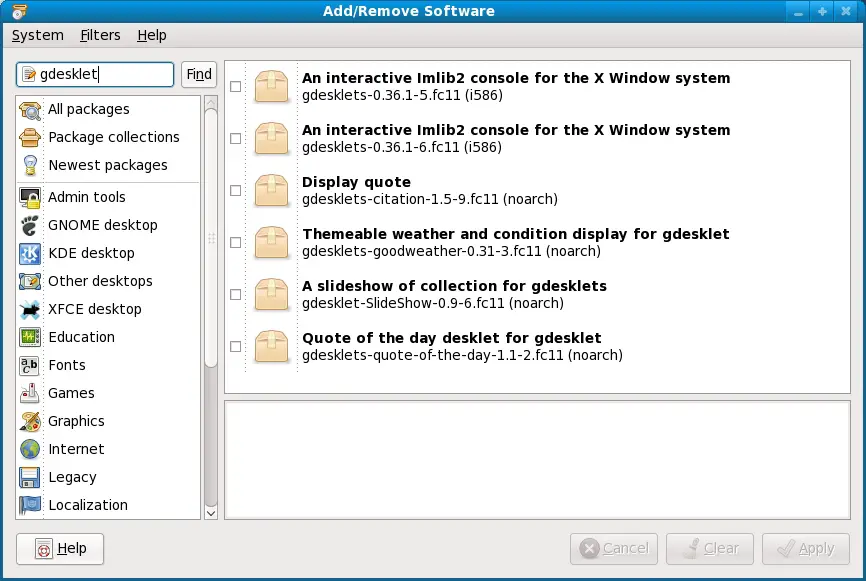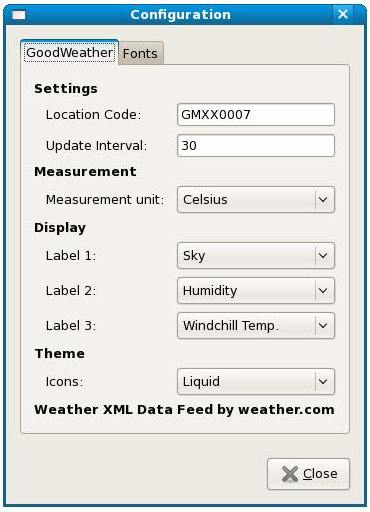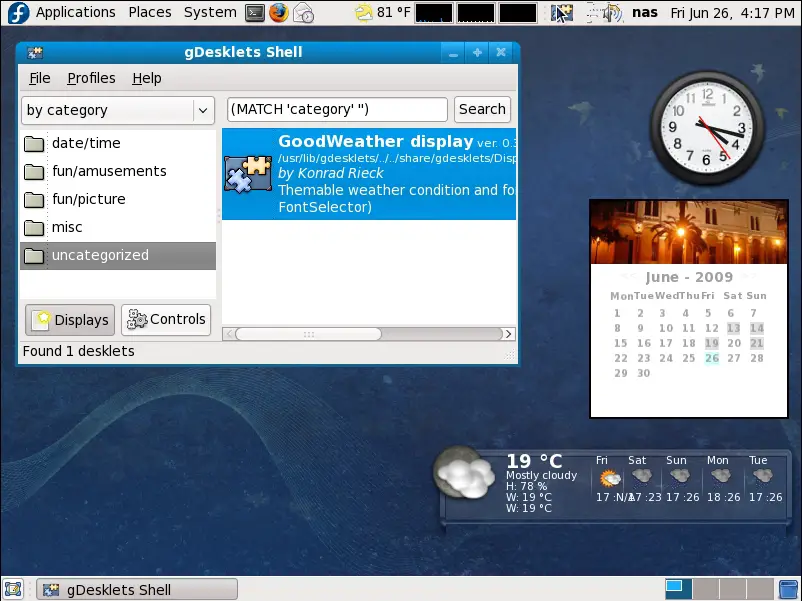Difference between revisions of "Enhance your Fedora Desktop with gDesklets"
m (Text replacement - "<table border="0" cellspacing="0" width="100%">" to "<table border="0" cellspacing="0">") |
m (Text replacement - "<table border="0" cellspacing="0">" to "<table border="0" cellspacing="0" width="100%">") |
||
| (4 intermediate revisions by the same user not shown) | |||
| Line 1: | Line 1: | ||
| − | <table border="0" cellspacing="0"> | + | <table border="0" cellspacing="0" width="100%"> |
<tr> | <tr> | ||
<td width="20%">[[Configuring the Fedora Desktop Menu System|Previous]]<td align="center">[[Fedora Desktop Essentials|Table of Contents]]<td width="20%" align="right">[[Browsing My Computer, Files and Folders on the Fedora Desktop|Next]]</td> | <td width="20%">[[Configuring the Fedora Desktop Menu System|Previous]]<td align="center">[[Fedora Desktop Essentials|Table of Contents]]<td width="20%" align="right">[[Browsing My Computer, Files and Folders on the Fedora Desktop|Next]]</td> | ||
| Line 54: | Line 54: | ||
<htmlet>fedora</htmlet> | <htmlet>fedora</htmlet> | ||
| + | |||
| + | <htmlet>ezoicbottom</htmlet> | ||
<hr> | <hr> | ||
| − | <table border="0" cellspacing="0"> | + | <table border="0" cellspacing="0" width="100%"> |
<tr> | <tr> | ||
<td width="20%">[[Configuring the Fedora Desktop Menu System|Previous]]<td align="center">[[Fedora Desktop Essentials|Table of Contents]]<td width="20%" align="right">[[Browsing My Computer, Files and Folders on the Fedora Desktop|Next]]</td> | <td width="20%">[[Configuring the Fedora Desktop Menu System|Previous]]<td align="center">[[Fedora Desktop Essentials|Table of Contents]]<td width="20%" align="right">[[Browsing My Computer, Files and Folders on the Fedora Desktop|Next]]</td> | ||
Latest revision as of 19:59, 27 October 2016
| Previous | Table of Contents | Next |
| Configuring the Fedora Desktop Menu System | Browsing My Computer, Files and Folders on the Fedora Desktop |
Take your Fedora Linux Skills to the Next Level |
If you've spent any time with Windows Vista you may have seen the small applets that run on the desktop, things such as a clock and a weather widget. It will probably come as no surprise to you that Linux had a feature like this long before Windows Vista came along. On the Fedora GNOME desktop this functionality is provided by technology called gDesklets. The creators of the gDesklets technology call it Eye candy for the desktop, and once you've had a change to see it in action you will understand why.
Installing gDesklets
The gDesklets packages are not installed by default with Fedora Linux. To use them, therefore, they must first be installed. To do so, begin by selecting Add/Remove Software from the System->Administration menu. In the resulting window use the Find text box search for gDesklets. Results similar to those shown below should be displayed:
Select each of the packages in the list and click on Apply to initiate the installation. Click Continue in both the confirmation and dependencies dialogs. The packages will then be downloaded and installed.
Launching gDesklets
Moving a Desklet
Once you have positioned a desklet it can be moved to a new location either by clicking the middle mouse button and dragging the desklet, or by clicking on it with the right hand mouse button and selecting Move Desklet. Move the mouse around until the desklet is in the desired position and click to set the location.
Raising Desklets to the Front of the Desktop
At any one time it is likely your desktop will contains all kinds of windows and dialogs. This means that most of the time any desklets you have installed and running will be obscured by your other windows. Recent versions of gDesklet have implemented a feature which allows any desklets to be brought in front of any windows on the desktop. By default this is triggered by pressing the Shift and F12 keys simultaneously. To send the desklets back to the back of any windows simply press Shift+F12 a second time.
Setting the Properties of a Desklet
Most desklets can be configured. For example the GoodWeather desklet allows the location for which the weather is being reported to be changed. To access a desklet's configuration page, click with the right mouse button and select the Configure desklet option. The following figure shows the GoodWeather properties dialog:
Install New gDesklet Packages
By default Fedora does not install all the currently available desklets. A more complete list of available desklets can be found at [http://www.gdesklets.de/index.php?q=desklet/browse/alphabetical/].
Any of these desklets can be downloaded for free and added to your desktop. To do so simply download your chosen desklets and start the gDesklet shell (Applications->Accessories->gDesklets). If you have saved the package file to your desktop, simply click and drag the package icon into the gDesklet Shell to install it. Alternatively, in the gDesklet Shell, select File->Install Package and in the file selection dialog navigate to the downloaded package, select it and click on the Open button. A dialog will appear informing you that the package has been installed. Browse the desklets in the gDesklet Shell window until you find the new desklet. Select it and launch it from the File menu.
The following figure shows a Fedora Desktop with the GoodWeather, clock and calendar desklets installed:
Take your Fedora Linux Skills to the Next Level |
| Previous | Table of Contents | Next |
| Configuring the Fedora Desktop Menu System | Browsing My Computer, Files and Folders on the Fedora Desktop |








